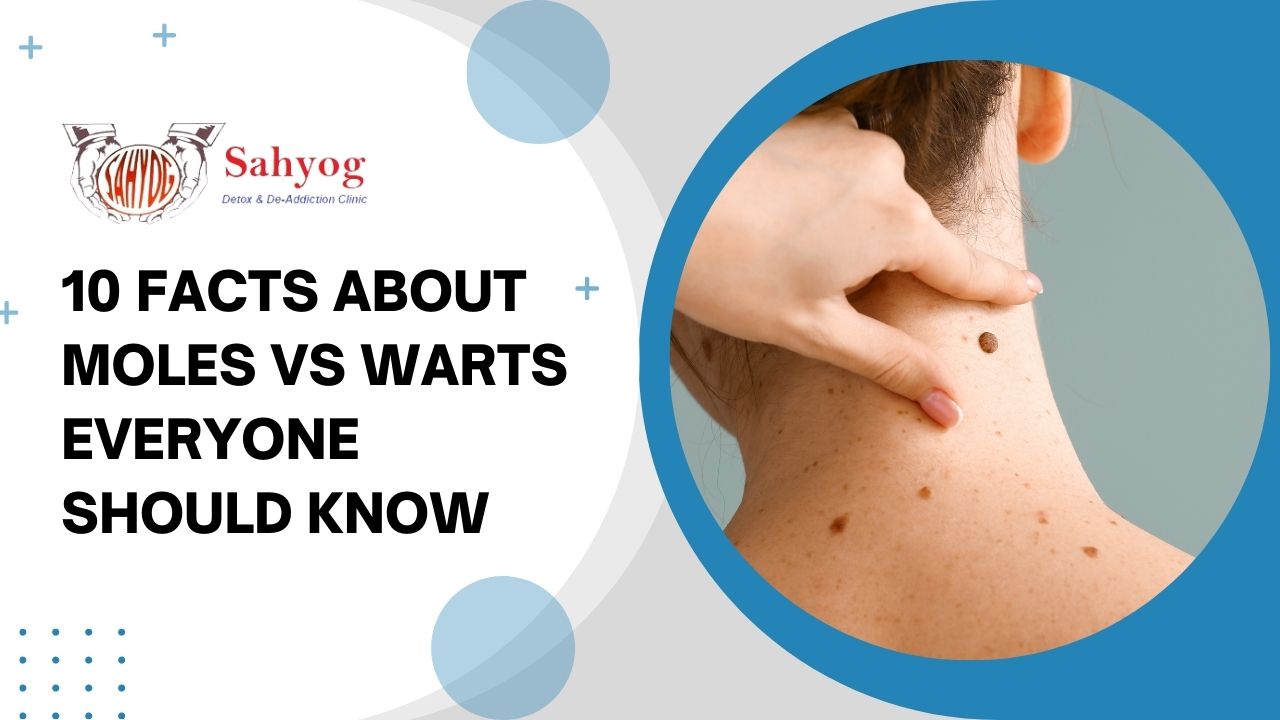10 Facts About Moles Vs Warts Everyone Should Know
Two typical skin growths that can arise on any region of the body are moles and warts. Despite having a somewhat similar appearance, they differ in terms of their traits, root causes, and methods of care. Knowing the difference between moles and warts is crucial because it might influence the type of therapy required and the dangers that can be associated. We’ll go over 10 facts about moles vs. warts in this post, including their similarities and distinctions, as well as how to spot and handle each. Continue reading to discover more, whether you want to be educated or you have a mole or wart yourself.
What are moles?
Moles are skin growths that often appear as black spots or lumps. They are available in a wide range of heights, forms, and colors, and can be either flat or raised. Moles are mostly safe, however, certain cases of malignancy have been documented. There are many different kinds of moles, including those that are present at birth, those that form later in life, and those that are larger, irregular in shape, and potentially cancerous. It is still uncertain what exactly causes moles, however, genetics and UV exposure are likely contributors. Moles can be removed for cosmetic reasons or monitored to see whether they are cancerous.
What are warts?
Warts are another type of skin growth that appear due to a viral infection of the skin’s outermost layer, the epidermis. They can range in size and shape from tiny, itchy bumps to larger, flat growths and typically take on a fleshy, white, or pink hue. Warts are most common on the hands and feet, although they can occur anywhere on the body. They are very contagious and can be spread through direct contact or by touching contaminated objects. Warts can be treated in several ways, from just being left alone to being surgically removed. It’s important to keep in mind that genital warts, among other types of warts, may increase a person’s chance of developing certain types of cancer.
Differences between moles and warts:
Moles and warts differ from one other in several ways, including:
- Warts normally have a flesh-colored or pink tone and a rough or lumpy texture, whereas moles are typically dark in color and may have hair coming from them.
- Warts are brought on by a viral infection in the epidermis of the skin, whereas moles are brought on by an overgrowth of melanocytes (skin cells that create color).
- Warts are more prevalent in youngsters, those with compromised immune systems, and those who come into touch with the virus that causes warts. Moles are more prevalent in persons with pale skin, those with a family history of moles, and those who are exposed to sunlight.
- Warts may itch or hurt, especially if they are on the hands or feet, but moles often do not produce any symptoms unless they develop into a malignancy.
- Moles are often identified by a dermatologist by a visual inspection; however, if there is a possibility of skin cancer, a biopsy may also be performed. Warts may typically be identified by their outward appearance, but if treatment is unsuccessful, a biopsy may be necessary.
- Moles can be left alone if they pose no risks, but warts can be removed surgically, using topical medicines, freezing, laser treatment, or any of these methods.
10 Facts About Moles Vs Warts Everyone Should Know:
Fact #1: Moles and warts are not the same things-
Skin growths, such as warts and moles, are not the same thing. Moles are caused by an overproduction of melanocytes, the cells responsible for giving skin its pigmentation, whereas warts are caused by a viral infection in the epidermis. Moles are normally flat and dark in color, while warts commonly have a raised, rough texture and a fleshy or pink tint. Knowing the differences between moles and warts is important for determining the best course of action and spotting any potential risks or concerns associated with these skin growths.
Fact #2: Moles and warts have different causes-
There is a wide variety of root reasons for warts and moles. Moles form when the skin produces too many melanocytes, which can be triggered by both genetics and UV exposure. The human papillomavirus (HPV) is the causative agent of warts, a viral infection of the skin. These factors can affect the appearance and response to the treatment of moles and warts. It is essential to understand the underlying cause of a skin growth to make an accurate diagnosis and pursue the appropriate therapy.
Fact #3: Moles and warts have different symptoms-
The symptoms of warts and moles can vary widely. Moles are normally flat and dark in color, while warts commonly have a raised, rough texture and a fleshy or pink tint. Moles can grow or shrink, and their borders may become irregular over time. However, warts may itch, pain, and even bleed if handled. They can also manifest alone or in clusters. Knowing the signs of moles and warts might help you detect them earlier and get the care you need.
Fact #4: Moles and warts can appear on different parts of the body-
Moles and warts can appear anywhere on the skin. Moles can show up anywhere on the skin, including the scalp, face, neck, chest, back, and arms. They may also appear on mucous membranes such as the ones lining the mouth, nose, and genitalia. Warts are common on the hands, feet, and genitalia, although they can occur anywhere on the body. Any part of the body is fair game for warts and moles, and their location may affect the treatment options available. You should visit a dermatologist if you notice any unusual growths on your skin.
Fact #5: Moles and warts can be treated differently-
Numerous methods exist for addressing moles and warts. Moles can be removed for cosmetic reasons or monitored to see whether they are cancerous. Small moles, that have stable borders and haven’t changed over time may be good candidates for observation. The mole can be scraped from the skin’s surface or the pigment cells can be killed with a laser if their removal is cosmetically necessary. Surgery to remove a mole may be necessary if doctors suspect it is cancerous.
Warts can be removed in several methods, including by being left alone, using topical medications, freezing, laser treatment, or surgery. Warts that aren’t bothersome and aren’t spreading to other parts of the body may be left alone and watched for a while. Topical medications, such as salicylic acid or imiquimod, can be used to eliminate the wart tissue. Cryotherapy, commonly known as freezing, involves putting the wart into a vat of liquid nitrogen and letting it freeze solid. In laser therapy, the wart tissue is burned off using a high-powered laser. Surgical removal may be necessary if noninvasive treatment methods fail.
Fact #6: Some moles can be cancerous-
Some moles are predisposed to cancer. While the vast majority of moles are completely safe for human health, a small percentage can develop into malignant melanoma. Keep an eye out for moles that bleed or become itchy, as well as any changes in size, shape, color, or texture. Uneven coloring or an abnormal shape may indicate that a mole is predisposed to become cancerous. If you notice a change in your mole, or if your mole looks unusual in any way, you must visit a dermatologist. Early detection and treatment of melanoma significantly increases the probability of a positive outcome.
Fact #7: Some warts can be contagious-
Warts may be infectious to others. Warts caused by the human papillomavirus (HPV) can be spread by direct contact with the virus. This can be contracted by direct skin-to-skin contact with a person who already has a wart, or through contact with infected surfaces or objects. Warts can spread from one part of the body to another if you scratch or contact them.
To reduce the risk of spreading warts, it is important to avoid touching them, whether they are on yourself or someone else. If you have a wart, you should not share towels, clothing, or other personal items with other individuals. Do not pick at or itch the wart; instead, keep the affected area clean and dry. Warts can spread easily, however, treatment can reduce the contagious period and eventually eradicate the virus.
Fact #8: Moles and warts can be prevented-
Avoidance of warts and moles is possible. While it may not always be possible, some steps may be taken to reduce the probability of developing warts or moles:
-If you want to reduce your risk of developing moles and warts, you should spend less time in the sun. Avoid going outside during the hottest parts of the day, put on protective clothing, and use sunscreen with a high SPF.
-The virus that causes warts can be spread by physical contact, thus it is important to practice great personal hygiene. Keep your possessions to yourself, wash your hands often, and cover up any scrapes or cuts.
-Scratching or touching a wart might cause it to spread to other parts of the body. Do not pick at your warts, and if they become bothersome, get medical attention.
-Keeping a close eye on your skin might alert you to changes in moles or the appearance of new growths. This might allow for early diagnosis and treatment, if necessary.
Fact #9: Moles and warts can be removed for cosmetic reasons-
Moles and warts can be surgically removed if the patient so desires. Some people may choose to have moles and warts removed for cosmetic reasons even though they are mostly harmless and do not require treatment. This may be the case if the growths are very large, obvious, or distressing to the individual.
Several methods exist for removing moles and warts, such as:
-When a mole or wart is excised, the skin is stitched back together.
-Cryotherapy involves freezing the growth using liquid nitrogen, which causes it to blister and fall off.
-The laser is used to cut off the growth in laser treatment
-Applying a lotion or solution directly on the growth might cause it to dry up and fall off in due time.
Fact #10: It’s important to see a doctor if you have a mole or wart that changes in appearance-
A doctor should be seen if a mole or wart changes in appearance. Although warts and moles are frequently harmless, changes in their size, shape, color, or texture may point to a more serious issue, such as skin cancer.
The American Academy of Dermatology suggests that people self-examine their skin regularly and have any new or changing growths checked by a dermatologist. The dermatologist may do a biopsy to determine whether the growth is cancerous or use a dermoscopy during a skin inspection to examine the tumor more carefully.
Conclusion:
In conclusion, moles and warts are both common skin growths that are often misidentified as something else. Despite some superficial similarities, such as appearance, they are not the same and have different causes, symptoms, or treatments.
It’s important to know the differences between moles and warts, as well as the risk factors for developing either. While moles and warts are often harmless, it is important to monitor their appearance for any changes and seek medical attention if necessary.
FAQS:
-
Can moles and warts be treated at home?
Warts and moles are not something you should try to eliminate on your own. Do-it-yourself removal methods run the risk of causing damage, scarring, or infection. If you have a mole or wart, you should probably see a dermatologist.
-
Can cancer develop in every wart or mole?
The vast majority of moles and warts are not cancerous and are instead harmless. The appearance of moles and warts can change over time, so it’s important to notice if there’s a change and get medical help if necessary.
-
What causes moles and warts?
Moles develop when melanocytes, the cells responsible for creating the skin’s color, multiply excessively. Warts are caused by the human papillomavirus (HPV), an infection that leads to abnormal skin growth.
-
Can you keep from getting warts or moles?
There are steps you may do to lessen your likelihood of developing a mole or wart, but unfortunately, there is no failsafe method. Following safe sun habits, staying away from people who may be carrying HPV, and practicing good hygiene are all examples of this.
-
Should you get a wart or mole removed if you don’t mind having them there?
If a mole or wart isn’t irritating or hasn’t altered in appearance, it usually doesn’t need to be treated. However, some people may want to have them removed because of how they affect their appearance. It’s important to discuss the potential risks and benefits of mole removal with a dermatologist before proceeding.


